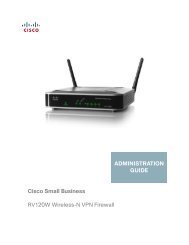Cisco Catalyst 6500 Supervisor 2T Architecture - Ipland
Cisco Catalyst 6500 Supervisor 2T Architecture - Ipland
Cisco Catalyst 6500 Supervisor 2T Architecture - Ipland
Create successful ePaper yourself
Turn your PDF publications into a flip-book with our unique Google optimized e-Paper software.
White PaperPFC4 <strong>Architecture</strong> Enhancement SummaryThe following section provides some details for the PFC4 architecture, its performance metrics, and an explanationof some of the feature enhancements that it introduces.PFC4 Forwarding <strong>Architecture</strong> and Performance MetricsThe forwarding architecture of the new <strong>Supervisor</strong> <strong>2T</strong> is based on the <strong>Cisco</strong> Express Forwarding (CEF) architecture,the same forwarding architecture used on the <strong>Supervisor</strong> 720. One of the primary enhancements of the <strong>Supervisor</strong><strong>2T</strong> (over the <strong>Supervisor</strong> 720) is the doubling of the centralized forwarding performance to 60 Mpps.The following sections provide an overview of the major changes in functionality, scalability, and performance forLayer 2 and Layer 3 forwarding features supported by the PFC4.Table 10.PFC4 Layer2 and Layer 3 Feature Comparison with Previous Generations of PFCsFeaturePFC3BSup 720-3BPFC3BXLSup 720-3BXLPFC3CSup 720-10G-3CPFC3CXLSup 720-10G-3CXLPFC4Sup <strong>2T</strong>PFC4XLSup <strong>2T</strong>-XLIPv4 forwarding 30 Mpps 30 Mpps 48 Mpps 48 Mpps 60 Mpps 60 MppsIPv6 forwarding 15 Mpps 15 Mpps 24 Mpps 24 Mpps 30 Mpps 30 MppsMPLS forwarding 30 Mpps 30 Mpps 48 Mpps 48 Mpps 60 Mpps 60 MppsLayer 2 forwarding 30 Mpps 30 Mpps 48 Mpps 48 Mpps 60 Mpps 60 MppsEoMPLS imposition 30 Mpps 30 Mpps 48 Mpps 48 Mpps 60 Mpps 60 MppsEoMPLS disposition 15 Mpps 15 Mpps 24 Mpps ** 24 Mpps ** 30 Mpps 30 MppsFIB TCAM 256 K 1 M 256 K 1 M 256 K 1 MAdjacency Table 1 M 1 M 1 M 1 M 1 M 1 MMAC (CAM) 64 K (32K) * 64 K (32K) * 96 K (80K) * 96 K (80K) * 128 K 128 KEtherChannel hash 3 bits 3 bits 3 bits 3 bits 8 bits 8 bits* The number outside of the brackets represents the maximum hardware capacity. The number inside the brackets represents theaverage utilization expected by users based on hash-based table programming. Note that average utilization can get up to themaximum hardware limit but that will depend on result of hashing.** Those numbers are for underlying IPv4 traffic only.MAC address learning continues to be performed in hardware, as was done with the <strong>Supervisor</strong> 720. The MAC(CAM) table in the <strong>Supervisor</strong> <strong>2T</strong> has been increased in size to 128 K and by using a new architecture the efficiencyhas been improved to 99 percent.The aggregate forwarding performance of the chassis will multiply by 60 Mpps for each DFC4-based linecard that isinstalled in the chassis. This facilitates an aggregate system performance up to 720 Mpps, assuming 6513-E.PFC4 Security and QoS <strong>Architecture</strong>Security and QoS functionality have been enhanced on the <strong>Supervisor</strong> <strong>2T</strong>. One of the main enhancements has beenthe move to a consolidated TCAM (memory) bank for holding Security and QoS ACLs that have been defined inSecurity and QoS Policies in the switch configuration. In previous PFC3x forwarding engines, there were twoseparate TCAM banks used for this purpose, each 32 K in size. One TCAM bank was used for Security ACLs andthe other bank was used for QoS ACLs.With <strong>Supervisor</strong> <strong>2T</strong>, up to 256 K entries are available for use (this is in the PFC4XL). By default in the PFC4XL, 64 Kentries are reserved for QoS, while 192 K entries are available for Security ACLs and related feature ACLs (such asNAT, WCCP, and others). Based on user-specified software configuration, up to 128 K entries can be madeavailable for QoS ACLs.Another major improvement is the ACE to mask ratio. An ACE is one ACL permit/deny statement that exists withinthe framework of an ACL. In the ACE statement, the mask is what is used to identify what portion of the address© 2011-2012 <strong>Cisco</strong> and/or its affiliates. All rights reserved. This document is <strong>Cisco</strong> Partner Confidential Information. Page 25 of 46
















